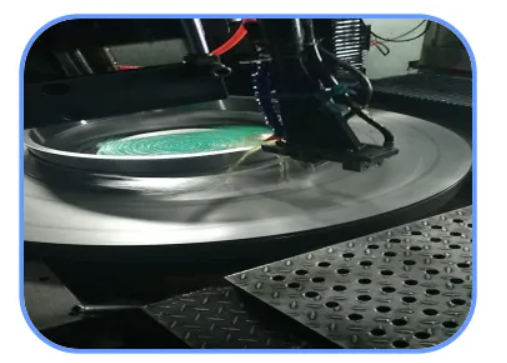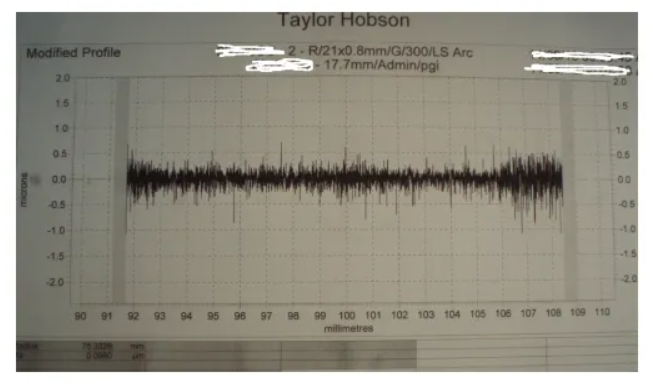
The superfinishing processing of raceways belongs to a type of surface finishing processing of rings. The main finishing processing methods include superfinishing, polishing, cross-polishing, abrasive tape grinding and finishing with a finishing machine, etc.
Bearing raceway superfinishing is the final process of raceway grinding. Superfinishing grinding refers to a finishing method in which, under good lubrication and cooling conditions (mostly oil-based superfinishing), a microcrystalline abrasive tool (oilstone) is used to apply a very small pressure to the workpiece in a direction perpendicular to the workpiece's rotation. The workpiece rotates at a certain speed, and the oilstone performs a fast and short reciprocating oscillation motion.
The reciprocating oscillation trajectory of the oilstone is consistent with the cross-sectional shape contour of the bearing raceway. To obtain better microscopic quality of the bearing raceway, it is usually divided into coarse superfinishing and fine superfinishing. The oilstones used have different thicknesses, and the cutting parameters selected are also different.
The use of oilstones for ultra-precision grinding of bearing raceways can achieve a very low surface roughness, improve the contour and waviness of the raceways, and eliminate the internal structural stress after grinding. After the bearing raceway undergoes oilstone superfinishing, a compressive stress raceway surface is formed, which enhances the contact fatigue strength of the rolling mill bearing raceway. Improve the quality of the oil film during the use of raceways and enhance the anti-corrosion ability of bearing raceways.

The quality of the rolling surface of the ring directly affects the working performance and service life of the bearing. Grinding processing, due to the high production efficiency requirements and the large selection of cutting parameters, is generally difficult to meet the final technical requirements for the raceway surface due to the influence of the grinding machine's precision, vibration, deformation, high temperature and cutting parameters. Quality parameters such as surface roughness, waviness, geometric shape accuracy and physical and mechanical properties of the surface layer must undergo finishing processing after grinding on the raceway surface of the ring to meet the technical requirements for bearing accuracy.
After the raceways of the bearing rings of the rolling mill are ground, there will be residual tensile stress from grinding on the surface of the raceways, which soften the surface layer (4-6 μm), resulting in low hardness. The roughness of the raceway is usually within Ra0.4 or Ra0.6, and the quality parameters such as waviness and raceway geometry have reached a certain level of precision. However, in order to obtain better surface quality of the raceway, it is still necessary to improve the microscopic quality of the bearing raceway surface through the superprecision grinding process. Superprecision grinding, as an extension and ultimate process of grinding processing, has the following techniques and functions:
1.Reduce the roughness of the raceway
In superfinishing grinding, the oilstone acts on the wave peaks rather than touching the wave troughs. When the grinding quality is very good, the superfinishing amount is usually around 3 to 5μm, and the roughness Ra of the raceway after superfinishing can reach within Ra0.25 or Ra0.4.
After reducing the roughness of the raceway surface of the rolling mill bearing, the wear of the raceway will be slowed down, the frictional resistance between the raceway and the rolling elements will be reduced, and the fatigue strength of the bearing will also be enhanced, thereby increasing the fatigue life of the bearing.‘’
Regardless of how well the two contact surfaces in relative motion in a bearing (such as between the raceways of the rings and the rolling elements) are lubricated, some wear will occur after long-term operation. Relatively rough surfaces are more prone to wear and have greater friction. A high coefficient of friction means that there is greater friction when sliding relatively than on smooth surfaces. A smaller roughness will enhance the bearing's anti-wear ability and reduce friction at the same time. A lower roughness will have corrosion resistance and chemical resistance.

2.Reduce the waviness of the raceway
In oilstone grinding, the surface of the raceway is in surface contact, and the arc of the contact is greater than the wavelength of the waviness of the workpiece surface. The waviness peaks will be removed during grinding, thereby reducing the waviness of the raceway (oilstone superfinishing only eliminates the waviness peaks on one side and does not eliminate the troughs). By improving the waviness, the vibration and noise of the bearing during high-speed operation have been reduced.
3.Improve the contour of the raceway shape
The oilstone reciprocates and oscillates, and the oscillation trajectory is consistent with the theoretical contour shape of the raceway cross-section. Through oscillation and grinding with a certain pressure of oilstone micro-abrasive, the local raceway shape can be effectively improved. It can be inspected by the light gap of the sample or detected by the roundness tester. Ultra-fine grinding can improve the raceway shape by 30%, improve the force condition of the raceway, and enhance the bearing raceway's load-bearing capacity.
4.A superprecision compressive stress layer is generated on the raceway surface
After grinding, a tensile stress layer will remain on the raceway surface, which has low hardness and is prone to fatigue and peeling. Superprecision grinding processing, through the reciprocating oscillation of oilstones, applies pressure to the raceway surface. After superprecision, residual compressive stress is formed on the raceway surface, making the surface structure of the raceway dense and enhancing the fatigue resistance and spalling resistance of the raceway surface.
5.Improve the quality of the oil film on the raceway surface during operation
By removing the surface peaks and reducing the roughness, the thickness of the oil film and the λ ratio were increased, the lubrication effect of the bearing was improved, the friction force was reduced, the quality of the oil film between the raceway and the rolling elements was guaranteed, the working temperature of the bearing was reduced, and the service life of the bearing was prolonged.
6.Improve the cleanliness of the bearing raceway surface
Due to the reduction of roughness, the wear debris and stains remaining on the surface of the bearing raceway are easier to clean and cannot remain on the surface of the bearing rings. The anti-rust and anti-chemical pollution capabilities of the bearing raceway are enhanced, reducing the wear of the bearing and extending its service life.